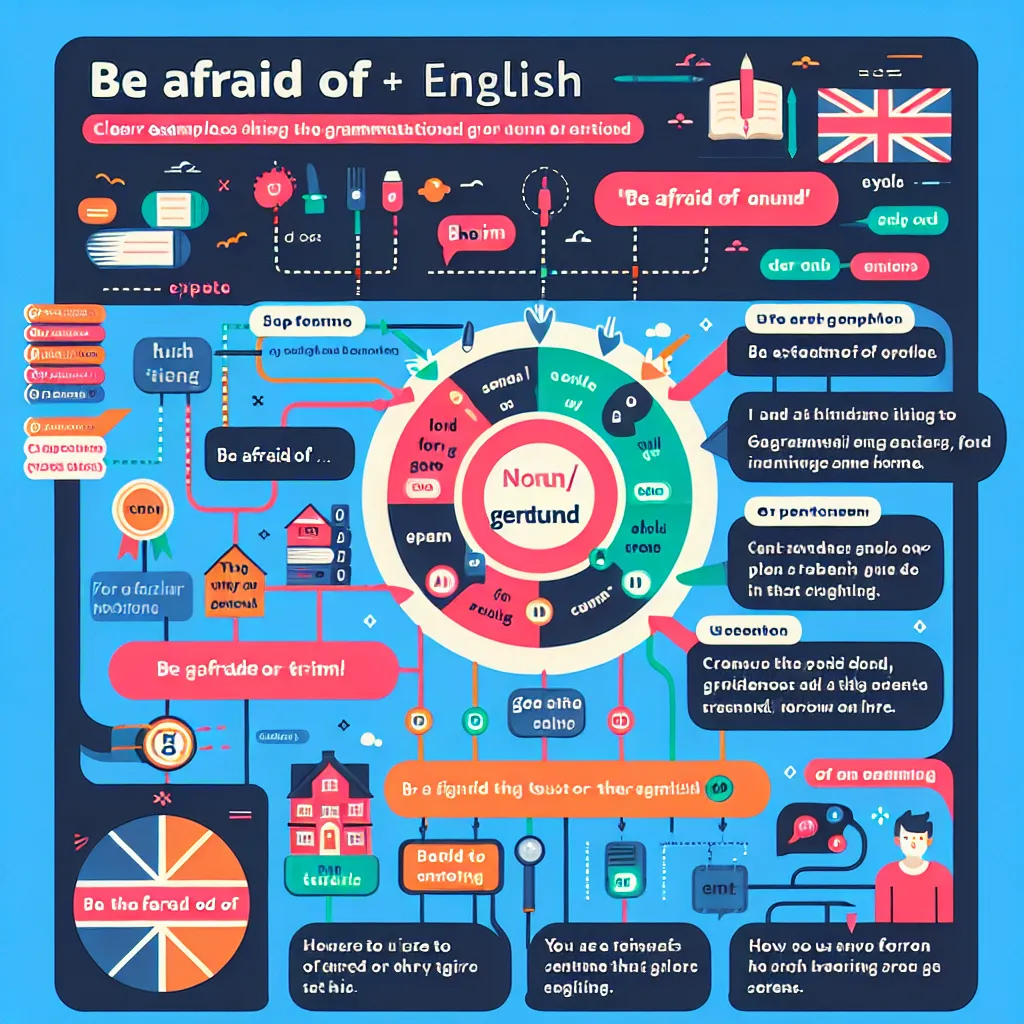The “be afraid of + noun/gerund” structure is a common expression used to convey fear or apprehension towards something. This grammatical pattern frequently appears in IELTS exams, making it crucial for test-takers to understand and use it effectively. Let’s delve into the intricacies of this structure and explore how to apply it in various IELTS contexts.
Understanding the “Be Afraid of + Noun/Gerund” Structure
The “be afraid of + noun/gerund” structure consists of three main components:
- The verb “be” (conjugated according to the subject)
- The adjective “afraid”
- The preposition “of” followed by either a noun or a gerund
This structure is used to express fear, worry, or concern about something or someone. It’s essential to note that both nouns and gerunds can follow “of” in this construction.
Examples:
- I am afraid of heights. (noun)
- She is afraid of flying. (gerund)
- They are afraid of the dark. (noun)
- We are afraid of losing our jobs. (gerund)
- He is afraid of public speaking. (gerund)
In each of these examples, the structure clearly conveys a sense of fear or apprehension towards the object or action mentioned.

Significance in IELTS and Frequency of Appearance
The “be afraid of + noun/gerund” structure is particularly relevant for IELTS candidates as it often appears in various sections of the test, including:
- IELTS Writing Task 2: When discussing societal issues, personal experiences, or hypothetical situations.
- IELTS Speaking: In Part 2 and 3, when describing fears, challenges, or personal opinions.
- IELTS Reading: In passages related to psychology, social sciences, or personal accounts.
- IELTS Listening: In conversations or monologues about personal experiences or emotions.
Understanding and using this structure correctly can significantly enhance your performance across all IELTS modules.
Grammar Formula and Usage
The basic formula for this structure is:
[Subject] + [be (conjugated)] + afraid of + [noun/gerund]
It’s important to remember that the verb “be” should agree with the subject in tense and number. For example:
- I am afraid of spiders.
- She was afraid of making mistakes.
- They will be afraid of the consequences.
Application in IELTS Writing
In IELTS Writing Task 2, you can use this structure to express concerns about societal issues or personal challenges. For example:
“Many people are afraid of technological advancements, fearing that they might lose their jobs to automation. However, I believe that we should not be afraid of embracing new technologies, as they often create new opportunities and improve our quality of life.”
Application in IELTS Speaking
During the IELTS Speaking test, you can use this structure to discuss personal fears or societal concerns. For instance:
Examiner: “What are some common fears people have in your country?”
Candidate: “In my country, many young people are afraid of unemployment. They worry about not finding suitable jobs after graduation. Additionally, some older individuals are afraid of technological changes, as they find it challenging to adapt to new systems and devices.”
Sample Passages and Band Score Analysis
Let’s examine how the use of “be afraid of + noun/gerund” can impact your IELTS scores:
Band 6 Example:
“Many people are afraid of change. They don’t like new things because they are scared. I think it’s not good to be afraid of change because the world is always changing.”
Band 7 Example:
“It’s common for individuals to be afraid of change, as it often brings uncertainty and challenges. However, I believe that being overly cautious and afraid of embracing new experiences can hinder personal growth and limit opportunities for success.”
Band 8-9 Example:
“The apprehension towards change is a prevalent human characteristic, with many individuals being afraid of disrupting their established routines. Nevertheless, I would argue that this fear, while understandable, can be detrimental to personal and societal progress. By being afraid of stepping out of our comfort zones, we risk stagnation and miss out on potentially transformative experiences that could enhance our lives and broaden our perspectives.”
The higher band score examples demonstrate more sophisticated vocabulary, complex sentence structures, and a deeper analysis of the concept, all while correctly employing the “be afraid of + noun/gerund” structure.
Common Mistakes and How to Avoid Them
-
Incorrect preposition: Using “from” instead of “of”
- Incorrect: I am afraid from dogs.
- Correct: I am afraid of dogs.
-
Omitting “of”:
- Incorrect: She is afraid flying.
- Correct: She is afraid of flying.
-
Using an infinitive instead of a gerund:
- Incorrect: They are afraid of to fail.
- Correct: They are afraid of failing.
-
Incorrect verb conjugation:
- Incorrect: We is afraid of the dark.
- Correct: We are afraid of the dark.
-
Using an adjective instead of a gerund:
- Incorrect: He is afraid of unsuccessful.
- Correct: He is afraid of being unsuccessful.
To avoid these mistakes, practice using the structure in various contexts and always remember the correct formula: [Subject] + [be (conjugated)] + afraid of + [noun/gerund].
Conclusion
Mastering the “be afraid of + noun/gerund” structure is crucial for IELTS success. By understanding its correct usage and practicing it in various contexts, you can enhance your language proficiency and express complex ideas more effectively. Remember to use this structure in your IELTS essays, speaking responses, and when answering reading and listening questions to demonstrate your grammatical competence and boost your overall performance.
To further improve your skills, try incorporating this structure into practice essays on topics such as technological advancements, environmental challenges, or personal development. This will help you become more comfortable using it in the actual IELTS exam and contribute to achieving a higher band score.
For more advanced grammar structures that can elevate your IELTS performance, you might want to explore the use of “for fear of + noun/gerund” or how to effectively use “despite” and “in spite of” in your writing and speaking.